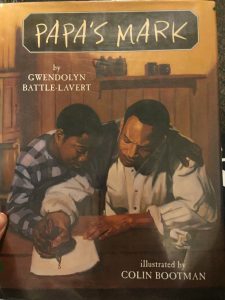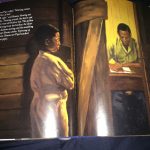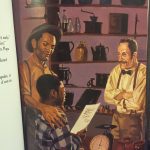 Author(s): Gwendolyn Battle-Lavert
Author(s): Gwendolyn Battle-Lavert
Illustrator/Photographer: Colin Bootman
Publisher and Year: Holiday House in 2004
Number of Pages: 30
Genre: Historical Fiction
Analysis:
This book is the story of how an African American boy named Simms, helped his father in becoming one of the first African Americans to vote in an election. Simms’s father does not know how to sign his name other than by just making a mark, therefore, Simms helps him learn how to write his name and encourages him and other African American men to vote in the election. In the end, Simms’s father and many other African American men vote despite any prior fears or uncertainties.
This book could serve as a window into seeing the injustice that many African Americans have faced, and still do today. This book could also function as a mirror for African American children, in which they may recognize the value of their culture and the role they play, as children, in their culture. I also believe that this story is a door for all people to really begin to recognize the racism that is still present in our world today, and encourage children to become advocates for their culture and their rights as humans. The illustrations that accompany the story portray the characters in a very accurate way, from the way they are dressed, to the expressions on their faces. The colors used throughout the book are fairly dark with a yellow and brown color scheme, which can represent the confinement felt by the African Americans in this book.
I thought that the author accurately described the challenges that faced many African Americans during the Civil Rights movement, and even after they earned the right to vote. This book does not go into much detail of what had happened in order for the African Americans to have the right to vote, but it does explain how literacy was one challenge for many African Americans and also the fear of what might happen to them if they do vote. Also, all throughout the story, Simms is always around to help his father like picking up groceries, teaching his father how to spell his name, making posters, and encouraging both his father and other African American males to vote which shows children that they are capable of helping their elders and making a difference in social justice situations. Simms can also be considered a symbol of younger generations and the huge impact they have on continuing the fight for civil rights.


